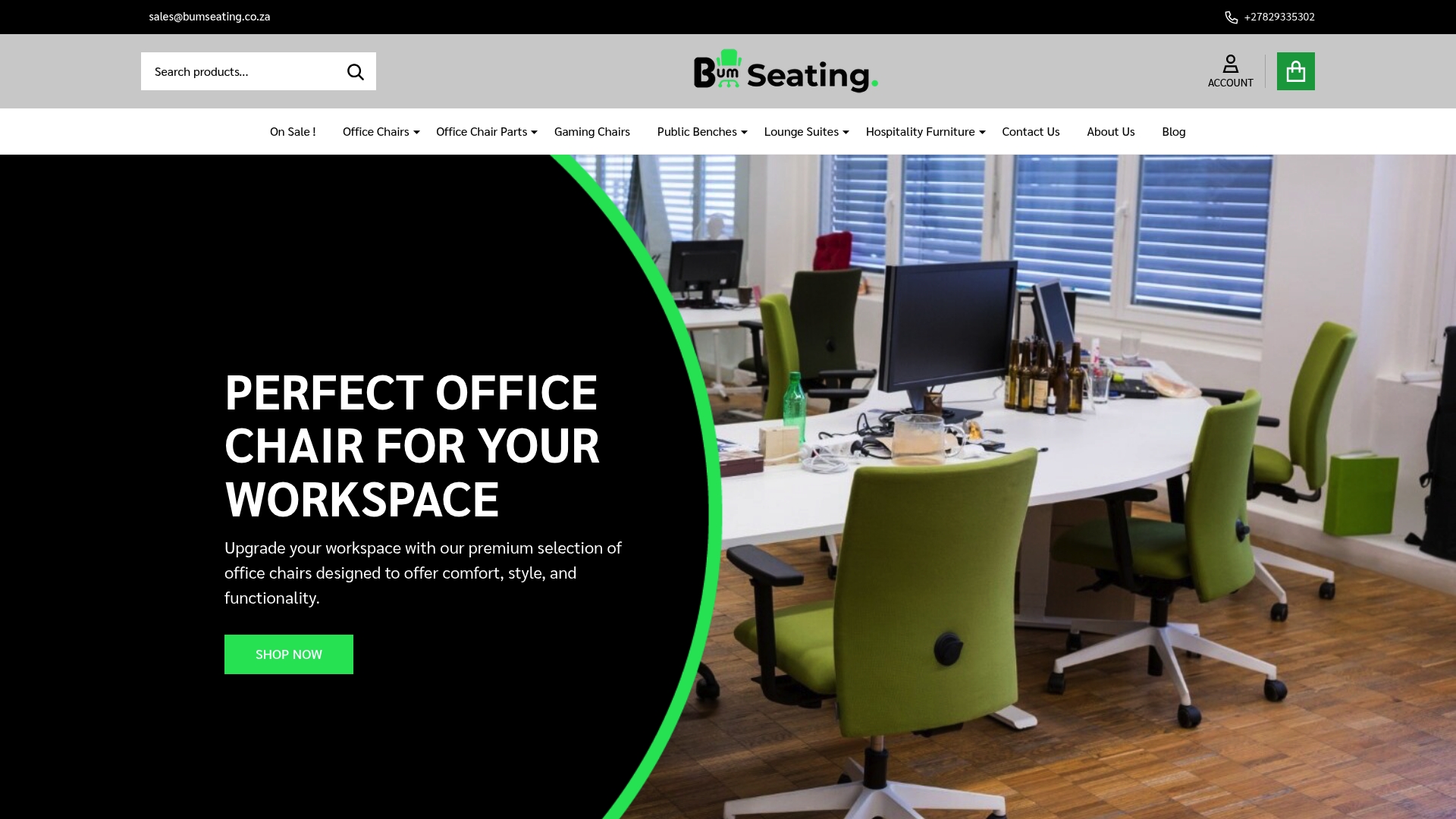Understanding Ergonomic Furniture Regulations in South Africa
20th Aug 2025
Understanding Ergonomic Furniture Regulations in South Africa

Workplace comfort is more than just a nice chair and a desk at the right height. South African regulations require specific ergonomic features like adjustable seats and lumbar support as a legal standard. Yet most people are shocked to discover that these rules do not only protect health but can actually increase productivity and reduce costs for businesses in surprising ways.
Table of Contents
- What Are Ergonomic Furniture Regulations?
- Why Ergonomic Furniture Regulations Matter for Health and Productivity
- Key Principles of Ergonomic Design in Furniture
- How Ergonomic Furniture Regulations Impact Businesses and Consumers
- Current Trends and Future Directions in Ergonomic Furniture Regulations
Quick Summary
| Takeaway | Explanation |
|---|---|
| Implement ergonomic assessments regularly | Conduct comprehensive evaluations to ensure workplace designs comply with ergonomic standards. |
| Invest in adjustable furniture | Choose furniture that allows personalisation to suit diverse employee needs for comfort and health. |
| Provide ergonomic training for employees | Educate staff on using ergonomic furniture properly to enhance health and prevent injuries. |
| Monitor workplace compliance | Continuously check that workplace setups adhere to ergonomic regulations to protect employee well-being. |
| Leverage technology for ergonomic solutions | Incorporate smart technologies to optimise workspace ergonomics and enhance worker comfort. |
What Are Ergonomic Furniture Regulations?
Ergonomic furniture regulations represent a critical framework designed to protect worker health and safety by establishing standardised guidelines for workplace seating and equipment design. In South Africa, these regulations are primarily governed by the Occupational Health and Safety Act (Act 85 of 1993) and related workplace standards that mandate specific requirements for furniture ergonomics.
Understanding the Legal Foundation
The legal foundation of ergonomic furniture regulations stems from comprehensive workplace safety principles. These regulations aim to prevent musculoskeletal disorders, reduce workplace injuries, and promote employee well-being. Key aspects include specifying minimum requirements for chair design, desk heights, adjustability features, and overall workplace configuration that supports proper human biomechanics.
Core Regulatory Elements Include:
To help clarify the key requirements set out by South African ergonomic furniture regulations, the table below summarises the core regulatory elements and the rationale for each.
| Regulatory Requirement | Purpose/Explanation |
|---|---|
| Mandated adjustability in seating | Allows users to personalise seating for comfort and health |
| Specific chair measurements | Ensures furniture fits a range of human body types |
| Lumbar support requirements | Promotes proper posture and alignment |
| Equipment positioning guidelines | Prevents unnecessary strain and repetitive injuries |
- Mandated adjustability in seating mechanisms
- Specific measurements for chair dimensions
- Requirements for lumbar support and posture alignment
- Guidelines for workplace equipment positioning
Implementation and Compliance Standards
Implementing ergonomic furniture regulations requires businesses to conduct comprehensive workplace assessments and invest in furniture that meets specific design criteria. Compliance involves not just purchasing appropriate furniture, but also training employees on proper usage and maintaining equipment to ensure ongoing effectiveness.

Learn more about ergonomic workplace solutions that meet South African regulatory standards and protect employee health. These regulations represent a proactive approach to workplace wellness, recognising that proper furniture design is fundamental to preventing long-term health complications associated with sedentary work environments.
Why Ergonomic Furniture Regulations Matter for Health and Productivity
Ergonomic furniture regulations are far more than bureaucratic guidelines; they represent a critical investment in human capital, workplace efficiency, and long-term employee health. These standards directly impact worker performance, physical well-being, and organisational productivity by addressing the complex relationship between workplace design and human physiology.
Physical Health Protection Mechanisms
Workplace ergonomic regulations serve as a preventative healthcare strategy, targeting musculoskeletal disorders that can emerge from prolonged incorrect seating and equipment usage. By mandating specific design requirements, these regulations mitigate potential health risks associated with sedentary work environments.
Key Health Impact Areas:
- Reduction of chronic back and neck pain
- Prevention of repetitive strain injuries
- Minimisation of workplace-related physical stress
- Long-term preservation of employee physical wellness
Productivity and Economic Implications
Beyond individual health benefits, ergonomic furniture regulations directly influence organisational productivity. Explore workplace wellness strategies that demonstrate how proper workplace design can reduce absenteeism, enhance employee engagement, and create more efficient work environments.
According to research from the International Journal of Environmental Research and Public Health, comprehensive ergonomic interventions can significantly decrease workplace injuries and improve overall worker performance. The economic benefits extend beyond immediate health considerations, encompassing reduced healthcare costs, lower worker compensation claims, and enhanced organisational resilience.
Key Principles of Ergonomic Design in Furniture
Ergonomic design in furniture represents a sophisticated approach to creating workplace solutions that seamlessly adapt to human physical requirements, promoting comfort, efficiency, and long-term health. By integrating scientific understanding of human biomechanics with innovative design strategies, manufacturers develop furniture that supports natural body movements and reduces physical strain.
Fundamental Design Considerations
Effective ergonomic furniture design prioritises adaptability, recognising that human bodies vary significantly in size, shape, and functional needs. The core principle involves creating flexible systems that can be customised to individual user requirements, ensuring maximum comfort and minimal physical stress across diverse workplace environments.
Critical Design Elements:
- Adjustable seat heights and depths
- Dynamic lumbar support mechanisms
- Adaptive armrest configurations
- Flexible backrest positioning
Biomechanical Alignment Strategies
Biomechanical alignment represents a crucial aspect of ergonomic furniture design. Discover advanced workplace seating solutions that scientifically address human movement patterns and postural requirements. According to research from the South African government’s occupational health guidelines, furniture design must proactively mitigate potential musculoskeletal risks by supporting natural spinal curvature and promoting balanced weight distribution.
The ultimate goal of ergonomic furniture design transcends mere comfort, focusing instead on creating intelligent, responsive environments that enhance human performance and well-being through thoughtful, scientifically informed design principles.
How Ergonomic Furniture Regulations Impact Businesses and Consumers
Ergonomic furniture regulations create a comprehensive ecosystem of responsibilities and benefits that fundamentally transform workplace environments, influencing both organisational strategies and individual consumer experiences. These regulations establish a critical framework that balances legal compliance, financial considerations, and human-centric design principles.
Business Compliance and Strategic Implications
The table below provides a side-by-side comparison of how ergonomic furniture regulations impact businesses versus consumers in South Africa, helping illustrate the dual focus of these standards.
| Area | Business Impact | Consumer Impact |
|---|---|---|
| Compliance Requirements | Must conduct risk assessments and documentation | Assurance of product meeting safety standards |
| Financial Considerations | Investments in compliant furniture and training | Access to high-quality, ergonomic products |
| Employee/Consumer Health | Reduced workplace injuries; improved productivity | Prevention of musculoskeletal disorders |
| Ongoing Obligations | Maintain records of interventions and modifications | Empowerment on safe product choices |
For businesses, ergonomic furniture regulations represent more than mere legal obligations. They function as strategic directives that compel organisations to invest in workplace infrastructure that directly impacts employee productivity, health, and overall organisational performance. Compliance requires comprehensive assessments, potential equipment modifications, and ongoing employee training.
Key Business Considerations:
- Mandatory workplace risk assessments
- Financial investments in appropriate furniture
- Regular employee ergonomic training programs
- Documentation and reporting of workplace modifications
Consumer Protection and Health Empowerment
Explore workplace wellness strategies that demonstrate how regulations protect consumer interests. According to research from South African government occupational health guidelines, these regulations empower consumers by establishing clear standards that manufacturers must meet, ensuring product quality, safety, and ergonomic effectiveness.
Ultimately, ergonomic furniture regulations represent a sophisticated approach to workplace design that transcends traditional compliance, creating an ecosystem where business interests, employee well-being, and consumer protection converge into a holistic framework of responsible innovation.
Current Trends and Future Directions in Ergonomic Furniture Regulations
Ergonomic furniture regulations are rapidly evolving, driven by technological advancements, changing workplace dynamics, and an increasing understanding of human physical interactions with workplace environments. These emerging trends reflect a sophisticated approach to workplace design that integrates health science, technological innovation, and regulatory frameworks.
Technology-Driven Regulatory Innovations
Modern ergonomic furniture regulations are increasingly incorporating digital technologies and data-driven approaches. Smart sensors, artificial intelligence, and advanced biomechanical monitoring systems are transforming how workplace ergonomics are assessed, implemented, and continuously optimised. This technological integration enables more precise, personalised ergonomic solutions that adapt to individual user requirements.
Emerging Technological Trends:
- AI-powered posture monitoring systems
- Adaptive furniture with real-time adjustment capabilities
- Biomechanical data collection and analysis tools
- Personalised ergonomic recommendations
Holistic Workplace Wellness Frameworks
Explore advanced workplace wellness strategies that demonstrate the evolving landscape of ergonomic regulations. According to research from South African government occupational health guidelines, future regulatory frameworks are moving beyond traditional compliance, emphasising comprehensive wellness approaches that integrate physical infrastructure, employee health, and organisational productivity.
The trajectory of ergonomic furniture regulations suggests a future where workplace design becomes increasingly intelligent, responsive, and fundamentally human-centric, bridging the gap between technological innovation and holistic employee well-being.
Ready to Stay Compliant and Comfortable? Explore Ergonomic Solutions that Meet South African Standards
Adapting to South Africa’s ergonomic furniture regulations can feel overwhelming, especially when workplace safety and employee wellness are on the line. The article highlights the real challenges of choosing the right seating to prevent discomfort, support good posture, and stay compliant with the Occupational Health and Safety Act. You want to protect your team from back pain and fatigue, but choosing trustworthy, regulation-ready office furniture is not always simple.

This is where Bum Seating steps in as your partner for ergonomic excellence. Our curated range of ergonomic office chairs is designed to align with local compliance standards, offering adjustability and lumbar support that foster real comfort and productivity. Why take chances with regulations or expose your business to costly mistakes? Shop now for chairs that look after your team and your legal peace of mind. Visit Bum Seating today to secure compliant, modern furniture before the next regulation update catches you off guard.
Frequently Asked Questions
What are ergonomic furniture regulations in South Africa?
Ergonomic furniture regulations in South Africa are guidelines established under the Occupational Health and Safety Act aimed at promoting worker health and safety through proper furniture design in workplaces.
Why are ergonomic furniture regulations important for employee health?
These regulations are crucial as they help prevent musculoskeletal disorders and reduce the risk of workplace injuries by ensuring that furniture design supports proper posture and alignment.
What features should ergonomic furniture include to comply with regulations?
Ergonomic furniture should offer key features such as adjustability in seat height and depth, lumbar support, flexible armrests, and proper backrest positioning to enhance comfort and minimize strain.
How can businesses ensure compliance with ergonomic furniture regulations?
Businesses can ensure compliance by conducting workplace assessments, investing in appropriate ergonomic furniture, providing employee training on proper usage, and maintaining records of ergonomic interventions.
Recommended
- Why Invest in Ergonomic Furniture for Your Office or Home - Bum Seating
- Essential Office Furniture Pieces for South African Workspaces 2025 - Bum Seating
- Ergonomic Furniture Basics: Your Guide to Healthy Spaces - Bum Seating
- Why Invest in Ergonomic Chairs for Offices and Homes - Bum Seating
- 2025 Office Furniture Regulations: A Compliance Guide - Office Furniture Dubai | Buy Modern Office Furniture Dubai - SAGTCO
